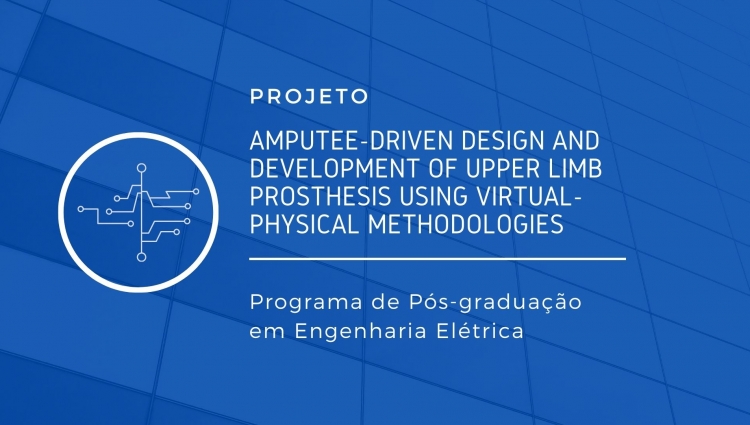Amputee-Driven Design and Development of Upper Limb Prosthesis using Virtual-Physical Methodologies
Publicado: 25/10/2023 - 14:38
Última modificação: 12/12/2023 - 09:28
Descrição: This proposal aims to conduct an international collaborative project between the Federal University of Uberlandia (Brazil) and the Qatar University (Qatar) in the development of low-cost prosthetic devices. The State of Qatar, through Qatar Red Crescent Society, is actively supporting the rehabilitation of the war-wounded victims in the region. The Federative Republic of Brazil, through the Ministry of Health, has the mandate to provide affordable prosthesis to its citizens who have lost their limbs due to traumatic events or who were born with limb deficiencies due to congenital disorders. The primary objective of this project is to investigate the feasibility of a virtual-physical approach in design and development of prosthetic arms. Any loss of a body part can cause massive emotional, psychosocial effect on individuals who have been affected. It can take a few months before the amputee's stump can fully heal and before any physical prosthesis can be worn. Also, current commercially available prostheses usually depend on high-end emerging technology with prohibitive costs for the majority of those who need such devices, especially in developing countries. Furthermore, existing upper-limb prostheses, capable of restoring a reasonable degree of functionally, to allow, for instance, dexterous manipulation of daily-life objects, require a lengthy, tiring, and sometimes frustrating, training period. In light of those, this project is composed of two parts. Firstly, we will develop an augmented reality platform so that an amputee can visualize himself or herself with an artificial arm to create an illusion that the limb is still present. This platform can be further used to evaluate the designs that the amputee prefers, and also as an auxiliary training system to help him or her to achieve proper prosthesis control. Secondly, we will integrate the technologies that the team members have developed to build a low-cost prosthesis for the amputee. Both teams have more than four-decades-long experience in additive manufacturing, touch sensing, and control of prosthetic arms. If successful, this project will push the boundaries in providing low-cost prosthetic arms to amputees in war-torn regions and developing countries..
Situação: Concluído; Natureza: Pesquisa.
ICT Executora: Universidade Federal de Uberlândia, Faculdade de Engenharia Elétrica, Programa de Pós-graduação em Engenharia Elétrica (PPGEELT)
Alcimar Barbosa Soares - Coordenador / Sérgio Ricardo de Jesus Oliveira - Integrante / Andrei Nakagawa Silva - Integrante / Edgard Afonso Lamounier - Integrante / Alexandre Cardoso - Integrante
ICT Parceira: Qatar University (https://www.qu.edu.qa/sites/)
AJohn-John Cabibihan - Integrante / Mohammed Roshun Paurobally - Integrante / M S Ajimsha - Integrante / Mohamed Ali Hammami - Integrante / Aya Gaballa - Integrante.
Artigos publicados:
Yinghe Sun, Christopher L. Hunt, Wally Niu, Ziwei Li, Gabriel Cyrino, Reidner Cavalcante, Edgard Lamounier, Alcimar B. Soares, and Nitish V. Thakor. 2021. A Comparison between Virtual Reality and Augmented Reality on Upper-limb Prosthesis Control. In 2021 International Symposium on Electrical, Electronics and Information Engineering (ISEEIE 2021). Association for Computing Machinery, New York, NY, USA, 521–528. https://doi.org/10.1145/3459104.3459189.
A. Nakagawa-Silva, N. V. Thakor, J. Cabibihan and A. B. Soares, "A bio-inspired slip detection and reflex-like suppression method for robotic manipulators," in IEEE Sensors Journal, 2019. doi: https://doi.org/10.1109/JSEN.2019.2939506.
D. Kumar, R. Ghosh, A. Nakagawa-Silva, A. B. Soares, N. V. Thakor, “Neuromorphic Approach to Tactile Edge Orientation Estimation using Spatiotemporal Similarity,” in Neurocomputing, 2020, doi: https://doi.org/10.1016/j.neucom.2020.04.131.
F. B. Liziardo, M. A. Silva, F. J. Arantes, F. C. Gregorio, P. R. A. Santos, F. F. R. Borges, A. Nakagawa-Silva, D. R. Bigaton, “Analysis of co-contraction of the trunk muscles in the side bridge stabilization with different unstable surfaces” in Bioscience Journal, 2018, doi: https://doi.org/10.14393/BJ-v35n2a20198-41833.
A. Nakagawa-Silva, S. P. Reddy Sunkesula, A. Prach, J. Cabibihan, N. V. Thakor and A. B. Soares, "Slip suppression in prosthetic hands using a reflective optical sensor and MPI controller," 2018 IEEE Biomedical Circuits and Systems Conference (BioCAS), Cleveland, OH, 2018, pp. 1-4. doi: https://doi.org/10.1109/BIOCAS.2018.8584711.
D. Balamurugan, A. Nakagawa-Silva, A. B. Soares et al., "Texture Discrimination using a Soft Biomimetic Finger for Prosthetic Applications," 2019 IEEE 16th International Conference on Rehabilitation Robotics (ICORR), Toronto, ON, Canada, 2019, pp. 380-385. doi: https://doi.org/10.1109/ICORR.2019.8779442.
Sriramana Sankar, A. Brown, D. Balamurugan, H. Nguyen, M. Iskarous, T. Simcox, D. Kumar, A. Nakagawa-Silva, N. V. Thakor, “Texture Discrimination using a Flexible Tactile Sensor Array on a Soft Biomimetic Finger”, 2019 IEEE Sensors Conference, Montreal, QC, Canada, 2019. https://doi.org/10.1109/SENSORS43011.2019.8956704
